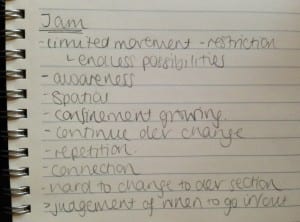Today’s experimentation focused on the ideas of attention and intention, related also to the form of dance. I found the beginning exercise much more engaging and effective due to learning of the idea that the body is always ready to move. My general warming up was enhanced by this as I felt I was more dynamic and creative in the way I prepared my body. This also made me conscious to which body parts needed more time and focus, enabling me to spend more time on them, while also preparing me mentally for the creative aspect of improvisation. Deborah Hay’s analysis of there being no front and that the body is made up of thousands of cells (De Spain, 2014, 94) impacted my movement choices. This was due to me focusing less on the way I was facing while ensuring I filled the space effectively. I also became aware of my full surface, providing the difference between awareness and attention as attention be an intentional full focus on something, closely observing this, where awareness involves you noticing something and being receptive but not constantly fixating on it (De Spain, 2014, 168). These worked in conjunction with each other as being aware meant I could note an aspect, leading to me being able to decide if it needed further attention. The idea of no front also reminded me that an audience member could be viewing the dance from any angle and therefore my movement needed to involve both the front, back and the sides of the body to interest all spaces around me. Focusing on the body being made of a high amount of taught me to have an awareness of the full surface of the body. This led to me finding new moves and experimenting with the body parts that often aren’t used, such as the fingers or elbow, creating movement that was led by that body part.
Through the next exercise of continue, develop, change, I learnt that my unconscious preference of movement is to develop. Being observed and also observing others improvise with this idea in their mind, noting points of development and change taught me that the dancer’s intentions are often much less obvious to an audience than they realise, which could answer the question as to why many practitioners do not use intentionality. Steve Paxton said “What I try to do is not intend and to find out” (De Spain, 2014, 70) which may be seen as a better option as it leaves the movement to be open to interpretation. I found that as I was dancing, in order to establish a movement, a high amount of repetition was needed. My partner’s clap for when they found it had been established arrived much later than I expected, leaving me expecting my movement to have become boring by the time I was set to change. Adding to this, I learnt that changing movement was much clearer when there was a strong change in the dynamics.
Adding attention to the exercise, in the form of each new movement needing an intention or theme, made the movement become much more therapeutic. This was one way in which form influenced improvisation. This effect was due to there being more connection established with the movement, making it harder to change; you had time to attend to the body’s needs and wants allowing for indulgence in the movement. Using attention contrasted with the playful nature of the previous task, creating a more glazed, indulged quality.
The score we used for our jam contained different forms of relationship. I found that this form reflected how I would categorise my own form. I focused on this greatly when participating, learning that when too many people were in the space the relationships became unclear while also others may join the group, pushing it to be too big requiring you leave. This related to the part I found hardest, judgement of when to enter or leave the space. The reason this became hard was due to not knowing other people’s intentions and therefore what you intend to do may not be possible if another participant changes. From this I found the best option was to follow my gut instinct and not spend time deciding. In the first two sections there was limited movement which created a restriction; however I learnt that through this there are still endless possibilities. This was by decisions as to whether to continue the same movement or to change frequently and when to add stillness. This task developed my awareness when improvising as there was a constant need to be aware of other people; I would need to note when the person leading the group changes movement but also when any other participants joined.
At the end of the session, I wrote down any key words or phrases that I felt influenced my work, describing best what I thought or felt throughout the improvisation. I have included a photograph of this below.
De Spain, K. (2014) Landscape of the Now. USA: Oxford University Press.
